KEY TAKEAWAYS:
Hip-hop beats typically follow a structure of intro, verse, chorus, verse, chorus, and outro. It’s a good rule of thumb, which does vary. The beats have a kick, snare, and hi-hat samples for drums, an 808 sound for bass, and usually some melody or chord progression on top.
Hip Hop Beats
Hip-hop is a fantastic genre to produce. It’s an expansive world of music that you can stretch out.
Whether you’re making a beat in Fl Studio or Ableton, it’s fun to create.
So many talented artists have risen in hip-hop, such as Kanye West, Busta Rhymes, Tyler The Creator, Denzel Curry, and Kendrick Lamar.
This article will discuss a good beat, how to make a hip-hop beat, and how to take your hip-hop beat to the next level.

How To Make Hip-Hop Beats
Hip-hop is such a diverse genre of music. From heavy-hitting trap beats to boom-bap to lo-fi hip hop. There are some common threads within these sub-genres. However, you can develop more characteristics in your hip-hop beats once you decide what style to follow.
How To Arrange Hip-Hop Drums
Let’s first look at the arrangement of the drums, which is such a crucial part of hip-hop beats. You can see the sounds associated with the MIDI notes in the image below, but I will clarify them. From top to bottom, the sounds are a hi-hat sample, two snare samples, and two kick samples.
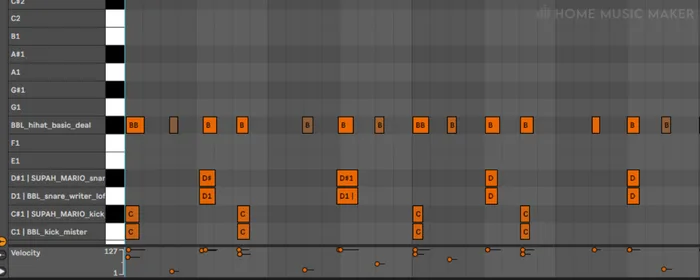
This is a classic hip-hop drum beat with a bit of variance on the hi-hat.
As you can see, the MIDI notes are not lined up precisely to the grid for this particular beat. This is on purpose, as this gives the drums a human element. Depending on the genre, you may want to quantize perfectly, but for this song, it works not being perfectly in time.
The kick samples are played on the first beat and in the middle of the second and third beats. This means you get a full beat between the first kick and snare, but the second kick of the bar comes in early, giving more groove to the beat.
The snares are on the second and fourth beat of the bar and provide that consistent snap we all love in a hip-hop beat.
Then the hi-hats loosely play eighth notes throughout the bar, but with varying velocities and some gaps. For this song, following the second kick with a gap in the hi-hats helps to add to the groove. The changes in velocity are purely from playing the samples on a MIDI controller, which further adds to the human feel I aim for in this beat.
What Sounds Do You Need To Make Hip Hop Beats?
Hip hop, at its core, has heavy kick drum samples, a snare sample that cracks or snaps, really sizzling hi-hats, and deep 808 bass sounds. From here, you can explore different sounds within different sub-genres.
For something like lo-fi hip hop, using filters to cut out some of the high ends of the drums, using a softer 808 sound, chopping up a sample, and adding some vinyl crackle is a great place to start.
For a modern hip-hop trap beat, you typically lean into punchy kick drum sounds, a snare that smacks, hi-hats that pierce through, and a boomy 808. You could also add a plucky melody over the top.
The critical thing with choosing sounds is listening and practicing. Listen to your favorite music over and over. Pick it apart. How does the bass sound? How hard do the drums knock? What kind of sound is being used in the melody? Does it sound vintage or modern?
Practice making beats with the elements you find in the music you love. The more you do this, the more you will develop your style.
What Tools Do You Need To Make Beats?
There are two ways to go about doing this. You can use a computer, or you can use some hardware. I will discuss both. However, I highly recommend using a computer for beginners. This is because it’s more visual and intuitive.
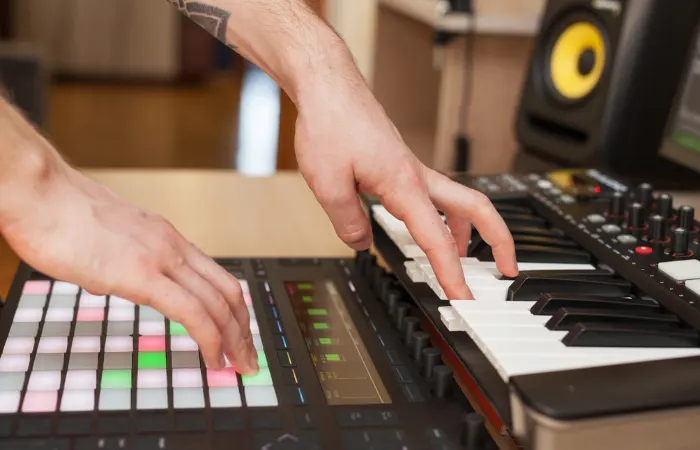
Using A Computer
Firstly, you’re going to need a digital audio workstation. This is where you will record, create sounds, manipulate sounds, arrange, and much more. It’s the core of music production on the computer.
My favorite DAW is Ableton Live 11. However, there are so many DAWs for all budgets, even for free. Spend some time looking at which DAW seems right for you.
Secondly, you will need an audio interface if you want to record real instruments on the computer. But don’t worry. There are interfaces out there for every price.
At the lowest end, while still having good sound quality, we have the Behringer U-Phoria UMC22. I cannot recommend the Focusrite Scarlett 2i2 more if you want a higher standard device.
When recording electric instruments, you can plug them into the interface. A microphone and XLR cable will be required when recording acoustic instruments or vocals.
Thirdly, you’ll need a way to hear your music. You can make music on whatever headphones you have around. Suppose you’re looking for a more professional set of headphones. In that case, though, I have been using the Beyerdynamic DT770 Pro for years and adore them.
Finally, suppose you want to play virtual instruments. In that case, you can use your computer keyboard (a feature in many DAWs), use the piano roll to write the MIDI in or use a MIDI controller. My recommendation for an inexpensive excellent MIDI controller is the AKAI MPK Mini.
Using Hardware
The other option for making beats is to use hardware. These are typically called sampler sequencers or groove boxes. They don’t require a PC; many are battery-powered, and they have everything you need besides headphones.
We have the Pocket Operator KO by Teenage Engineering on the simplest end of beat-making hardware. This compact device allows you to record in samples using the built-in mic or the eighth-inch jack input, which you can then sequence and add effects to.
It has a steep learning curve. Due to its small size, every aspect of the device is multi-functional. Getting to a point where you can freely use music to create music takes time, but it’s a fun and affordable piece of equipment.
On the more complex side of beat-making hardware, we have the Roland SP404 MKII. This is a fantastic piece of gear. You can record samples, vocals, or instruments using the dedicated guitar/mic input, the mono/stereo line input, or the MIDI input.
It has so many effects, including a guitar amp simulator. You have 16 GB of internal storage, with the option to expand using an SD card. It also has a 32-voice polyphony. It has loop recording capabilities, a graphic display, and much more.
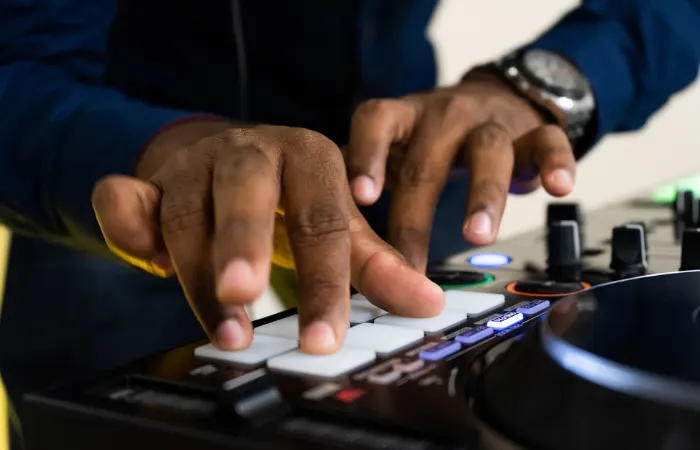
How To Structure Hip Hop Beats
As a rule of thumb, hip-hop beats contain intros, verses, and a chorus (hook). The standard order for these are:
- Intro
- Verse
- Chorus (Hook)
- Verse
- Chorus (Hook)
Of course, there are songs with extra elements and a completely different structure, but this is the most common.
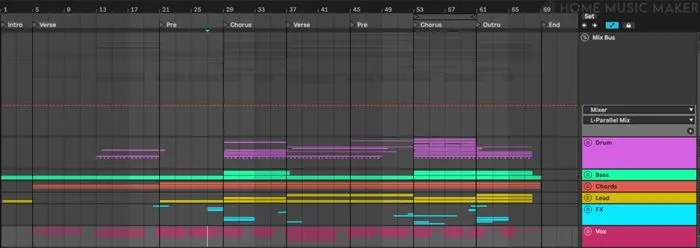
How you arrange a hip-hop beat is essential in keeping it exciting and impactful. The order is the second most important part of arranging. The real magic happens in how you arrange each section. Let’s look in detail.
Intro
This is the first thing the listener hears, so getting this right is crucial to keep them from skipping your song. On the other hand, you don’t want it to be too busy and big if you plan on dropping it hard in the verse.
Every song is different, so it’s essential to match the intro to the vibe of the song and the vibe of the section following. Saying that, if you’re stuck, I do have some tips.
- Include the catchy elements of the song here, whether it’s a vocal soaked in reverb or a synth, as it will draw people in.
- Put a low-pass filter to make the intro less bright, making the next section hit so much harder.
- Keep it essential. Only include parts that are critical elements of the song, without minimal drums.
Verse
The verses are really about laying down the foundations of the song. You’re creating a theme through lyrics and music that supports the song’s hook.
I usually build from the hook of the song. I then create the verses with a similar vibe but stripped back. For example, I will remove the 808s or the lead instrument melodies. This way, the verses are less potent than the chorus and help create a dynamic song.
If there are multiple verses, then I will change each verse slightly. For example, the second verse may contain some extra percussion that the first didn’t have, or the second verse is even more stripped back.
Chorus
This is the big moment of the song. This is where the catchy vocal hook is. It’s where all of the catchy instrumental melodies live. It’s the part of the song that the listener is waiting for.
Don’t rely on the vocals to be the only catchy part. Include catchy ideas within as many of the instrumental parts as you can. However, be cautious not to overcrowd the beat and take away from the vocals. All the details need to be working together.
I also will build each chorus throughout the song. It gets bigger and bigger until it peaks in the last chorus for that final big moment. This can be as simple as layering an existing keyboard melody with a different keyboard sound. Just keep the song evolving.
Tips To Make Your Hip Hop Beats Bang
Of course, I could go on for days about different ways to make your hip-hop beats pop even harder, but I’ve chosen my 5 top tips for this.
An Amazing Hook
Think of every excellent hip-hop song; 99% have an incredibly catchy hook. Candy Shop by 50 Cent, California Love by 2Pac ft. Dr. Dre and Who Dat Boy by Tyler, The Creator all have unforgettable hooks. You want something that people can sing or rap along to and cannot get out of their heads.
A Good Sample Choice
A great sample that fits your song is vital (if you’re using samples). Use more than just a sample that you think is popular. Choose a sample that serves a purpose to the song. My first thought of this is Bound 2 by Kanye West, though he has been highly offensive over the last few years.
If you want to start sampling and are using FL Studio, you should look at our article on how to sample in FL Studio.
Keep It Simple
You want to make sure a song is manageable with the necessary elements. You want the essential parts of the music that add to the emotion and feeling. One of the biggest hip-hop tunes ever is Hypnotize by The Notorious BIG. It has drums, bass, and the occasional horn stab as its instrumentation. But it still sounds massive.
Referencing
Analyze your favorite tracks. Implement what they are doing into your music. Just as a guitarist learns covers, to begin with, this is your time to learn from your heroes. Try anything and everything to broaden your artistic palette.
FX Samples
Using risers and impacts in your music to emphasize big moments or to make the beat groove more is an excellent way to up the level of your beats. Dr. Dre was very good at this. He would use a reverse kick drum at the start of drum loops so that it sounded like you were almost falling into the loop. Tension and release are fundamental in impactful music.
What Makes A Good Beat?
A good beat is attractive but catchy. You want to create a rhythm with variations and layers, some evolution and change, but retain its identity. You want a beat with a catchy hook, where people can latch on and feel the song’s vibe.
In the verses or other sections, having variation is excellent for progressing the song. But when that hook hits, you want it to feel like a familiar friend you’re waiting for. We’re all ready to sing/rap along to that great hook. But it’s not oversaturated.
When you have a good beat and want to reach out for collaborations, check out our article on contacting rappers.
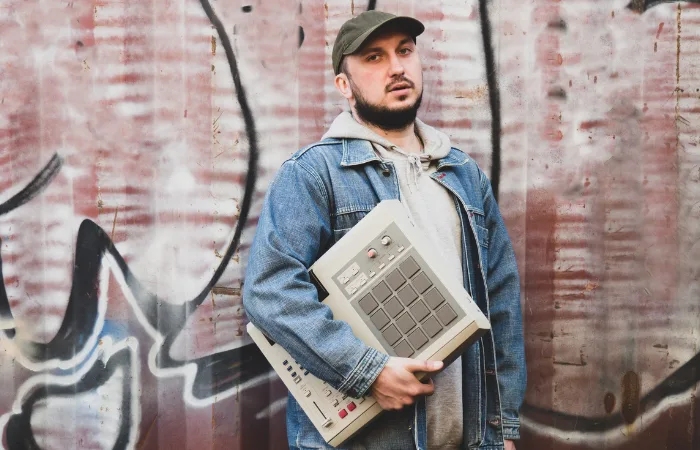
Final Words
When making hip-hop, it’s such an expansive world to get lost in. Follow your instinct based on the analytical listening of your favorite song. Once the beat is made, it may be time for you to think about the lyrics.
Related Questions
How Many Sounds Does A Hip Hop Beat Have?
Depending on the style, the number of sounds can be minimal or expansive. Some songs have their sounds down to the bare roots of drums, bass, and a melody. Others have lush chord progressions with layers of synths and many melodies on top of the essential elements.
What Is A Hook In Rap?
A hook is typically the chorus of the song. It’s the catchiest part of the vocals and is repeated throughout the song.
What Do Rappers/Producers Use To Make Beats?
Producers/rappers use a digital audio workstation to make beats. This is the home hub of all music making within a computer. Examples of a DAW are Fl Studio, Ableton, REAPER, Pro Tools, and Logic Pro.
What Is Flow In Rap?
Flow in rap is the relationship between the rhythm and the rhymes of the lyrics, whether it’s a fast or slow rap. How complex the rhythm of the lyrics is. The intricacy of the rhymes.
READ NEXT:
For more information on lyrics and their importance, check out our article on whether lyrics matter in a song.

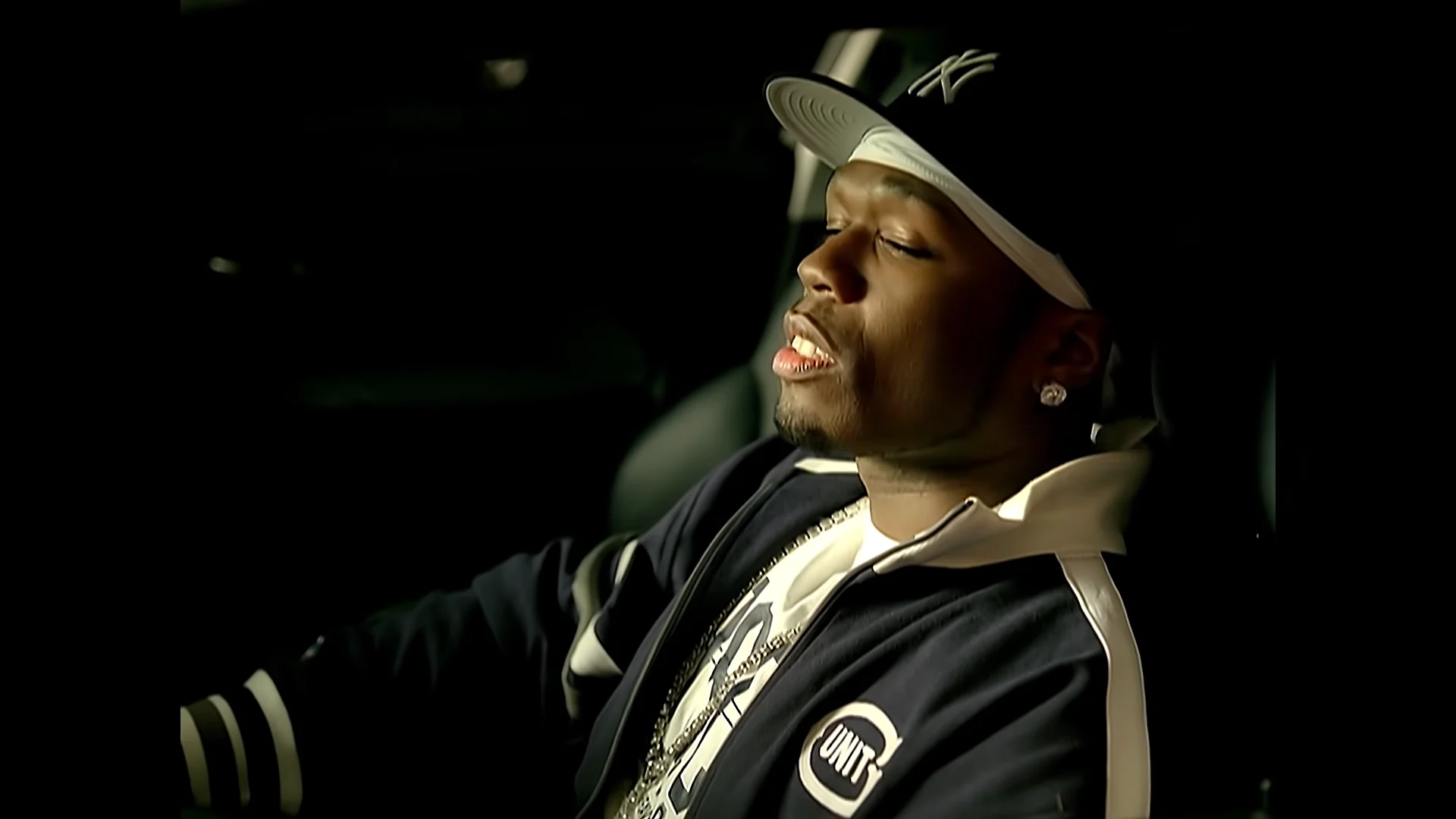
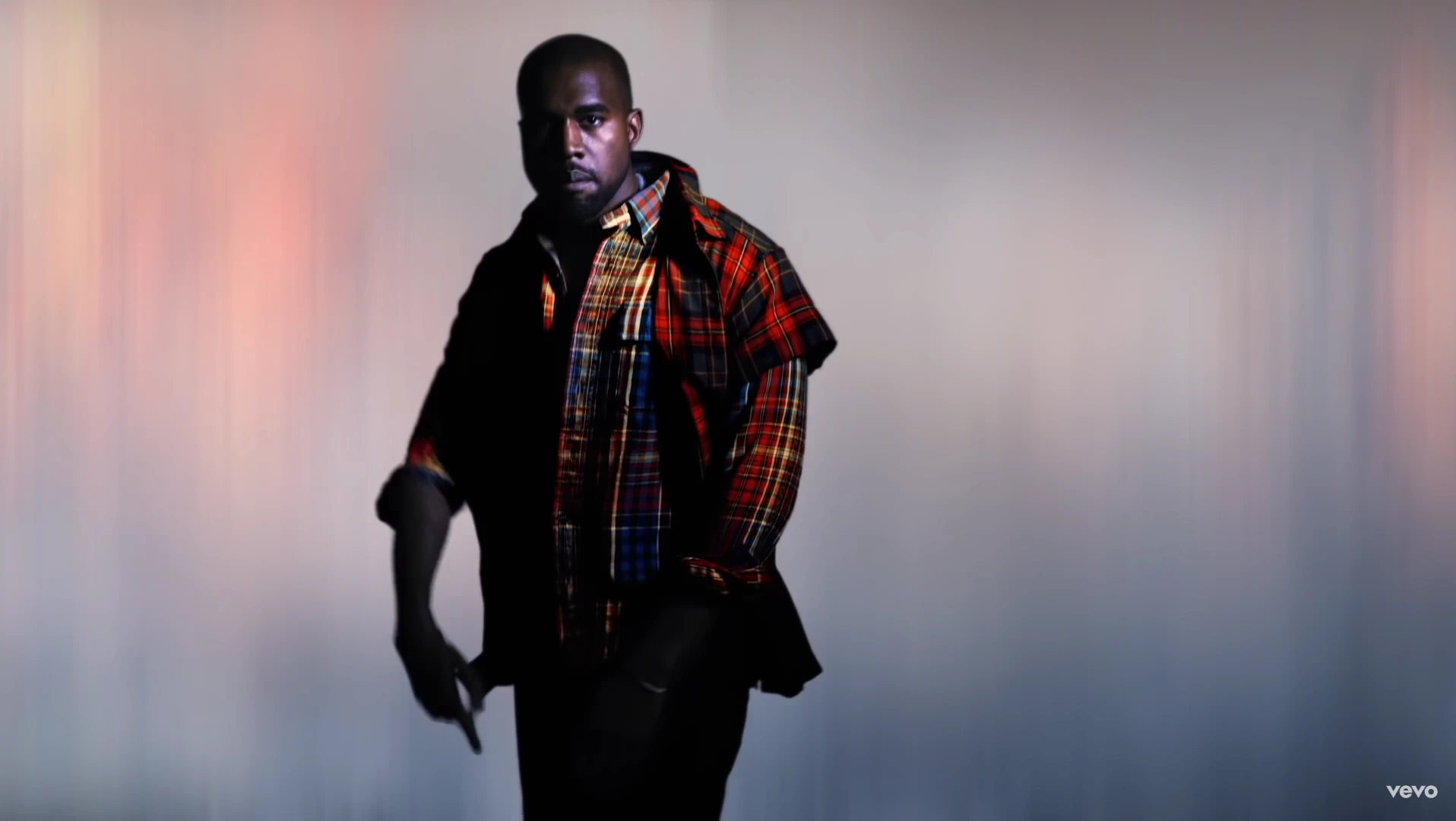
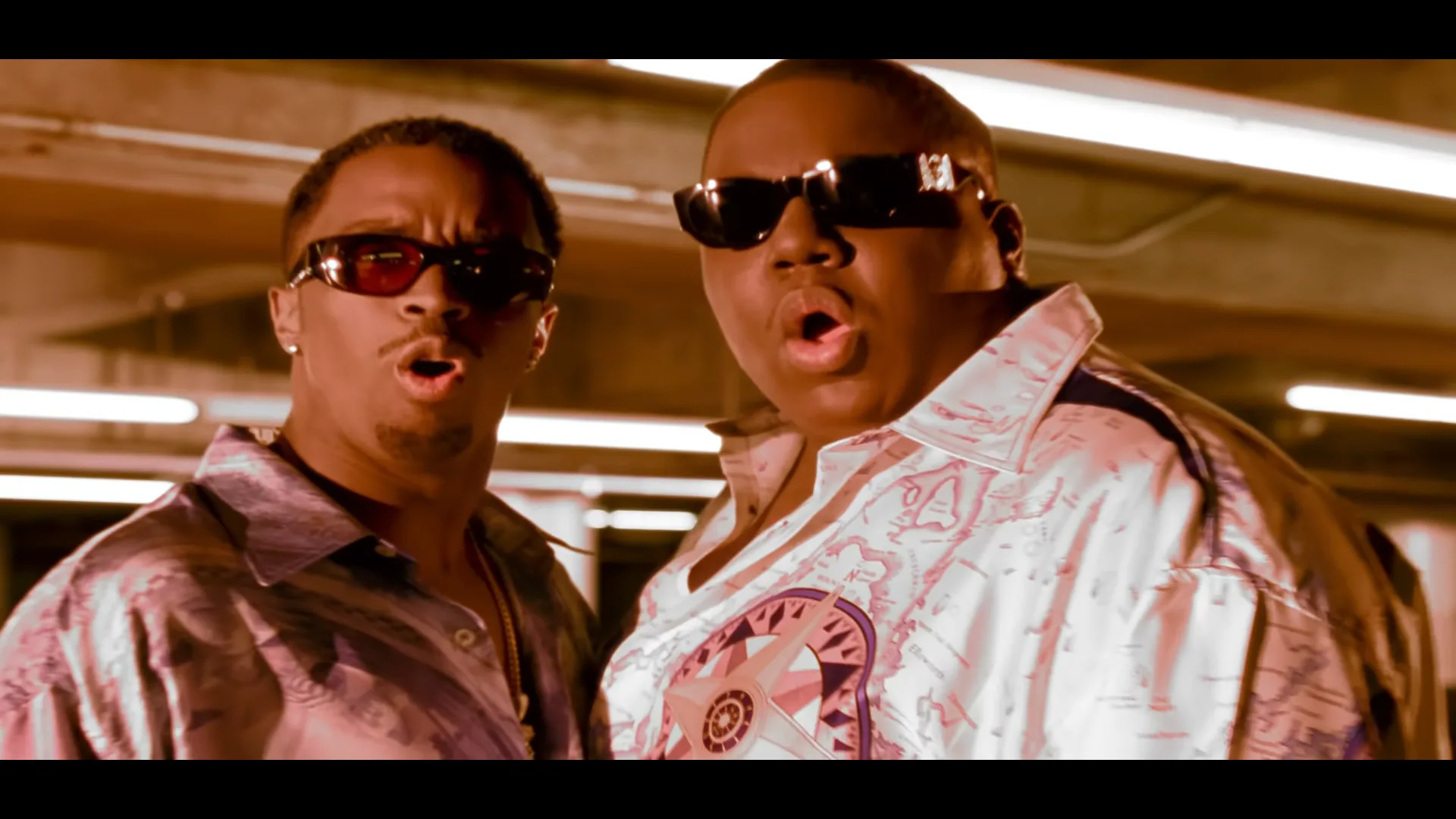
 Want to connect with other music producers for help and guidance?
Want to connect with other music producers for help and guidance?